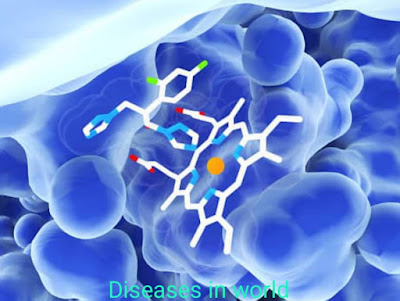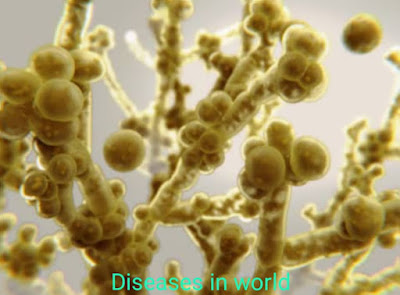How dangerous is Candida auris (a new worldwide infection)?
1 The CDC has issued the following causes of concern for Candida auris: Candida auris | Candida auris | Fungal diseases CDC
2 Candida auris is an emerging fungus that poses a serious threat to global health. CDC is concerned about C. auris for three main reasons:
3 It is often multidrug safe, meaning that it is safe for some of the antifungal drugs commonly used to treat Candida infections. Few types are reserved for all three accessible classes of antifungals.
 |
| Candida auris |
This has led to outbreaks in healthcare settings. For this reason, it is important to inflame the distinctive proof of C. auris in the hospitalized permanently so that well-being offices take extraordinary precautions to anticipate its spread.
US map: Candida aureus clinical cases by US state as of March 31, 2020
A total of 1092 cases were confirmed in the US. The hot spots are New York (496) and Illinois (310).
A single case of C. auris has been reported from Austria, Belgium, Chile, Costa Rica, Egypt, Greece, Italy, Iran, Norway, Poland, Switzerland, Taiwan, Thailand, and the United Arab Emirates.
Cases of C. auris have been reported from Australia, Bangladesh, Canada, Colombia, France, Germany, Japan, Kenya, Malaysia, Netherlands, Pakistan, Panama, Russia, and Saudi Arabia. Singapore, South Africa, South Korea, Spain, Sudan, the UK, the USA, and Venezuela. Several of these countries have documented widespread transmission of C. auris in multiple clinics.
US cases of C. auris have been found in patients who had recently stayed in healthcare facilities in India, Kenya, Kuwait, Pakistan, South Africa, South Korea, the United Arab Emirates, and Venezuela. Cases are also documented.
How can you prevent Candida auris?
Usually, it comes down to "very complex infection control," says Dr. Udalja. This means that hospital and nursing home rooms need to be cleaned thoroughly and that people interacting with patients need to practice good hand hygiene to prevent infection.
 |
| prevent Candida auris |
7 Signs of Candida Overgrowth (Plus How to Get Rid of It)
Many types of parasites live inside and outside the human body, including a yeast called Candida. Candida is commonly found in the mouth and digestive tract, and in small amounts on the skin. At a normal level, biology is not a problem. Either way, when candida starts to get out of control, it can lead to an infection known as candidiasis.
➣ Taking antibiotics
➣Eating foods high in sugar and refined carbohydrates
➣Excessive alcohol consumption
➣ A weakened immune system
➣ Taking oral contraceptives
➣Diabetes
➣ High-stress levels
When Candida begins to overproduce, it can cause a variety of health problems. This article explores 7 signs of Candida overgrowth and how you can treat it.
1. Oral thrush
Candidiasis that occurs in the mouth or throat is called "thrush". It is most common in infants, the elderly, and people with weakened immune systems. People who have poor oral hygiene or have removable teeth are also at higher risk. People with oral thrush usually develop white, rough patches on their tongue, inner cheeks, gums, tonsils, or throat.
2. Fatigue and Fatigue
One of the most common side effects associated with Candida is impotence. There is no evidence that candida causes fatigue, but there are several ways it can contribute. Candida contamination as a run-through and through shows when the immune system is weakened.
3. Recurrent genital or urinary disorders
Candida is most commonly found in the female vaginal tract. Its excess can lead to vaginal candidiasis, also known as yeast infection: 75% of all women will have at least one vaginal yeast infection in their lifetime, and less than half of these are Estimated to reoccur at least once. Men can also get genital yeast infections, but usually less frequently. Side effects of vaginal candidiasis include redness, swelling, itching, painful intercourse, and a thick, white discharge from the vagina.
4. Stomach problems
Gastrointestinal health depends on the balance of the "great" and "scary" microbes living in your gut. The "bigger" microorganisms that normally live in the intestines are essential for absorption because they help produce starch, fiber, and some sugars. When the microbes in your gut are unbalanced, you will experience stomach problems such as B. Constipation, diarrhea, nausea, gas, cramps, and gas.
5. Sinus infection
Chronic sinus infections affect one in eight adults in the United States. Common symptoms include a runny nose, nasal congestion, bad breath, and headache. While most short-term sinus infections are caused by bacteria, many long-term, chronic sinus infections are believed to be fungal. A study done by the Mayo Clinic looked at a group of 210 people with chronic sinus infections and 96 percent of them had fungus in their mucus.
6. the skin and nail Fungal infections
Just like in your gut, there are bacteria on your skin that keep Candida from getting out of control. All bacteria thrive under different conditions, including different temperatures, humidity, or acidity levels. This is why changes in the environment on your skin can allow Candida to overproduce. For example, cosmetics, soaps, and moisturizers can alter skin conditions, especially antibacterial types.
7. Joint pain
When candida impurity enters the circulation framework and spreads throughout the body, it can affect the joints and cause joint pain. Candida joint pain is related to joint pain, snugness, and swelling. Hips and knees are the most affected.



.jpg)

.jpg)


